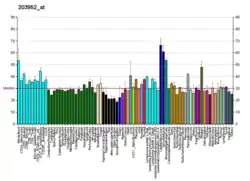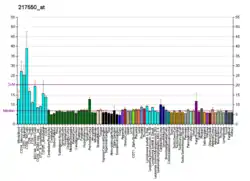ATF6
Activating transcription factor 6, also known as ATF6, is a protein that, in humans, is encoded by the ATF6 gene[5][6][7] and is involved in the unfolded protein response.
Function
ATF6 is an endoplasmic reticulum (ER) stress-regulated transmembrane transcription factor that activates the transcription of ER molecules.[8] Accumulation of misfolded proteins in the Endoplasmic Reticulum results in the proteolytic cleavage of ATF6. The cytosolic portion of ATF6 will move to the nucleus and act as a transcription factor to cause the transcription of ER chaperones.
See also
Interactions
ATF6 has been shown to interact with YY1[9] and Serum response factor.[6]
References
- GRCh38: Ensembl release 89: ENSG00000118217 - Ensembl, May 2017
- GRCm38: Ensembl release 89: ENSMUSG00000026663 - Ensembl, May 2017
- "Human PubMed Reference:". National Center for Biotechnology Information, U.S. National Library of Medicine.
- "Mouse PubMed Reference:". National Center for Biotechnology Information, U.S. National Library of Medicine.
- Hai TW, Liu F, Coukos WJ, Green MR (December 1989). "Transcription factor ATF cDNA clones: an extensive family of leucine zipper proteins able to selectively form DNA-binding heterodimers". Genes Dev. 3 (12B): 2083–90. doi:10.1101/gad.3.12b.2083. PMID 2516827.
- Zhu C, Johansen FE, Prywes R (September 1997). "Interaction of ATF6 and serum response factor". Mol. Cell. Biol. 17 (9): 4957–66. doi:10.1128/MCB.17.9.4957. PMC 232347. PMID 9271374.
- Meex SJ, van Greevenbroek MM, Ayoubi TA, Vlietinck R, van Vliet-Ostaptchouk JV, Hofker MH, Vermeulen VM, Schalkwijk CG, Feskens EJ, Boer JM, Stehouwer CD, van der Kallen CJ, de Bruin TW (July 2007). "Activating transcription factor 6 polymorphisms and haplotypes are associated with impaired glucose homeostasis and type 2 diabetes in Dutch Caucasians". J. Clin. Endocrinol. Metab. 92 (7): 2720–5. doi:10.1210/jc.2006-2280. PMID 17440018.
- "Entrez Gene: ATF6 activating transcription factor 6".
- Li M, Baumeister P, Roy B, Phan T, Foti D, Luo S, Lee AS (2000). "ATF6 as a transcription activator of the endoplasmic reticulum stress element: thapsigargin stress-induced changes and synergistic interactions with NF-Y and YY1". Mol. Cell. Biol. 20 (14): 5096–106. doi:10.1128/MCB.20.14.5096-5106.2000. PMC 85959. PMID 10866666.
Further reading
- Hai T, Hartman MG (2001). "The molecular biology and nomenclature of the activating transcription factor/cAMP responsive element binding family of transcription factors: activating transcription factor proteins and homeostasis". Gene. 273 (1): 1–11. doi:10.1016/S0378-1119(01)00551-0. PMID 11483355.
- Hai TW, Liu F, Coukos WJ, Green MR (1990). "Transcription factor ATF cDNA clones: an extensive family of leucine zipper proteins able to selectively form DNA-binding heterodimers". Genes Dev. 3 (12B): 2083–90. doi:10.1101/gad.3.12b.2083. PMID 2516827.
- Zhu C, Johansen FE, Prywes R (1997). "Interaction of ATF6 and serum response factor". Mol. Cell. Biol. 17 (9): 4957–66. doi:10.1128/MCB.17.9.4957. PMC 232347. PMID 9271374.
- Yoshida H, Haze K, Yanagi H, Yura T, Mori K (1999). "Identification of the cis-acting endoplasmic reticulum stress response element responsible for transcriptional induction of mammalian glucose-regulated proteins. Involvement of basic leucine zipper transcription factors". J. Biol. Chem. 273 (50): 33741–9. doi:10.1074/jbc.273.50.33741. PMID 9837962.
- Haze K, Yoshida H, Yanagi H, Yura T, Mori K (1999). "Mammalian Transcription Factor ATF6 Is Synthesized as a Transmembrane Protein and Activated by Proteolysis in Response to Endoplasmic Reticulum Stress". Mol. Biol. Cell. 10 (11): 3787–99. doi:10.1091/mbc.10.11.3787. PMC 25679. PMID 10564271.
- Li M, Baumeister P, Roy B, Phan T, Foti D, Luo S, Lee AS (2000). "ATF6 as a Transcription Activator of the Endoplasmic Reticulum Stress Element: Thapsigargin Stress-Induced Changes and Synergistic Interactions with NF-Y and YY1". Mol. Cell. Biol. 20 (14): 5096–106. doi:10.1128/MCB.20.14.5096-5106.2000. PMC 85959. PMID 10866666.
- Yoshida H, Okada T, Haze K, Yanagi H, Yura T, Negishi M, Mori K (2001). "Endoplasmic Reticulum Stress-Induced Formation of Transcription Factor Complex ERSF Including NF-Y (CBF) and Activating Transcription Factors 6α and 6β That Activates the Mammalian Unfolded Protein Response". Mol. Cell. Biol. 21 (4): 1239–48. doi:10.1128/MCB.21.4.1239-1248.2001. PMC 99577. PMID 11158310.
- Ye J, Rawson RB, Komuro R, Chen X, Davé UP, Prywes R, Brown MS, Goldstein JL (2001). "ER stress induces cleavage of membrane-bound ATF6 by the same proteases that process SREBPs". Mol. Cell. 6 (6): 1355–64. doi:10.1016/S1097-2765(00)00133-7. PMID 11163209.
- Parker R, Phan T, Baumeister P, Roy B, Cheriyath V, Roy AL, Lee AS (2001). "Identification of TFII-I as the Endoplasmic Reticulum Stress Response Element Binding Factor ERSF: Its Autoregulation by Stress and Interaction with ATF6". Mol. Cell. Biol. 21 (9): 3220–33. doi:10.1128/MCB.21.9.3220-3233.2001. PMC 86961. PMID 11287625.
- Gotoh T, Oyadomari S, Mori K, Mori M (2002). "Nitric oxide-induced apoptosis in RAW 264.7 macrophages is mediated by endoplasmic reticulum stress pathway involving ATF6 and CHOP". J. Biol. Chem. 277 (14): 12343–50. doi:10.1074/jbc.M107988200. PMID 11805088.
- Chen X, Shen J, Prywes R (2002). "The luminal domain of ATF6 senses endoplasmic reticulum (ER) stress and causes translocation of ATF6 from the ER to the Golgi". J. Biol. Chem. 277 (15): 13045–52. doi:10.1074/jbc.M110636200. PMID 11821395.
- Thuerauf DJ, Morrison LE, Hoover H, Glembotski CC (2002). "Coordination of ATF6-mediated transcription and ATF6 degradation by a domain that is shared with the viral transcription factor, VP16". J. Biol. Chem. 277 (23): 20734–9. doi:10.1074/jbc.M201749200. PMID 11909875.
- Okada T, Yoshida H, Akazawa R, Negishi M, Mori K (2002). "Distinct roles of activating transcription factor 6 (ATF6) and double-stranded RNA-activated protein kinase-like endoplasmic reticulum kinase (PERK) in transcription during the mammalian unfolded protein response". Biochem. J. 366 (Pt 2): 585–94. doi:10.1042/BJ20020391. PMC 1222788. PMID 12014989.
- Luo S, Lee AS (2002). "Requirement of the p38 mitogen-activated protein kinase signalling pathway for the induction of the 78 kDa glucose-regulated protein/immunoglobulin heavy-chain binding protein by azetidine stress: activating transcription factor 6 as a target for stress-induced phosphorylation". Biochem. J. 366 (Pt 3): 787–95. doi:10.1042/BJ20011802. PMC 1222838. PMID 12076252.
- Tardif KD, Mori K, Siddiqui A (2002). "Hepatitis C Virus Subgenomic Replicons Induce Endoplasmic Reticulum Stress Activating an Intracellular Signaling Pathway". J. Virol. 76 (15): 7453–9. doi:10.1128/JVI.76.15.7453-7459.2002. PMC 136367. PMID 12097557.
- Shuda M, Kondoh N, Imazeki N, Tanaka K, Okada T, Mori K, Hada A, Arai M, Wakatsuki T, Matsubara O, Yamamoto N, Yamamoto M (2004). "Activation of the ATF6, XBP1 and grp78 genes in human hepatocellular carcinoma: a possible involvement of the ER stress pathway in hepatocarcinogenesis". J. Hepatol. 38 (5): 605–14. doi:10.1016/S0168-8278(03)00029-1. PMID 12713871.
- Okada T, Haze K, Nadanaka S, Yoshida H, Seidah NG, Hirano Y, Sato R, Negishi M, Mori K (2003). "A serine protease inhibitor prevents endoplasmic reticulum stress-induced cleavage but not transport of the membrane-bound transcription factor ATF6". J. Biol. Chem. 278 (33): 31024–32. doi:10.1074/jbc.M300923200. PMID 12782636.
- Newman JR, Keating AE (2003). "Comprehensive identification of human bZIP interactions with coiled-coil arrays". Science. 300 (5628): 2097–101. Bibcode:2003Sci...300.2097N. doi:10.1126/science.1084648. PMID 12805554. S2CID 36715183.
External links
- ATF6+protein,+human at the US National Library of Medicine Medical Subject Headings (MeSH)
- Human ATF6 genome location and ATF6 gene details page in the UCSC Genome Browser.
This article incorporates text from the United States National Library of Medicine, which is in the public domain.
This article is issued from Wikipedia. The text is licensed under Creative Commons - Attribution - Sharealike. Additional terms may apply for the media files.





